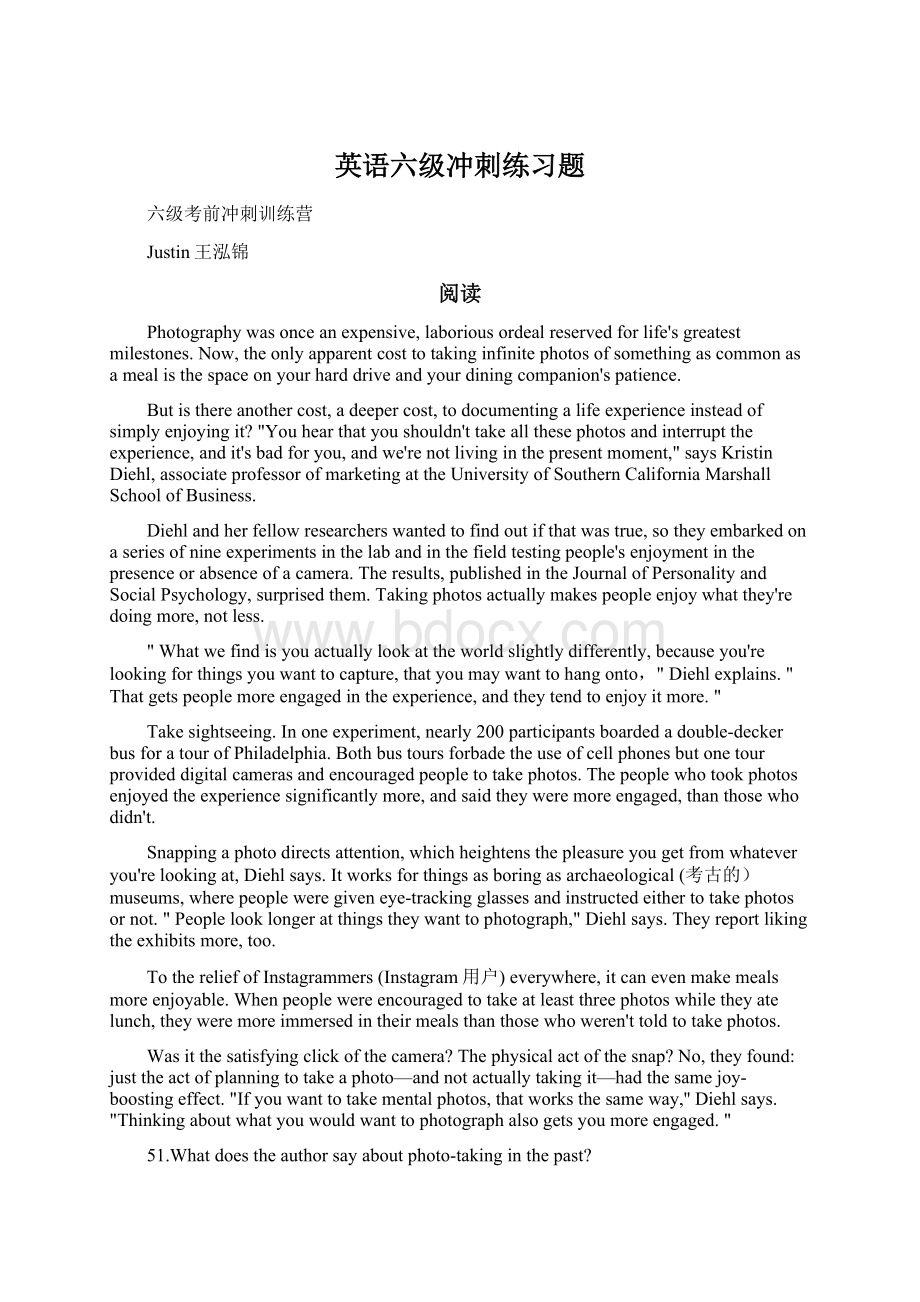英语六级冲刺练习题Word格式.docx
《英语六级冲刺练习题Word格式.docx》由会员分享,可在线阅读,更多相关《英语六级冲刺练习题Word格式.docx(10页珍藏版)》请在冰豆网上搜索。

Youhearthatyoushouldn'
ttakeallthesephotosandinterrupttheexperience,andit'
sbadforyou,andwe'
renotlivinginthepresentmoment,"
saysKristinDiehl,associateprofessorofmarketingattheUniversityofSouthernCaliforniaMarshallSchoolofBusiness.
Diehlandherfellowresearcherswantedtofindoutifthatwastrue,sotheyembarkedonaseriesofnineexperimentsinthelabandinthefieldtestingpeople'
senjoymentinthepresenceorabsenceofacamera.Theresults,publishedintheJournalofPersonalityandSocialPsychology,surprisedthem.Takingphotosactuallymakespeopleenjoywhatthey'
redoingmore,notless.
"
Whatwefindisyouactuallylookattheworldslightlydifferently,becauseyou'
relookingforthingsyouwanttocapture,thatyoumaywanttohangonto,"
Diehlexplains."
Thatgetspeoplemoreengagedintheexperience,andtheytendtoenjoyitmore."
Takesightseeing.Inoneexperiment,nearly200participantsboardedadouble-deckerbusforatourofPhiladelphia.Bothbustoursforbadetheuseofcellphonesbutonetourprovideddigitalcamerasandencouragedpeopletotakephotos.Thepeoplewhotookphotosenjoyedtheexperiencesignificantlymore,andsaidtheyweremoreengaged,thanthosewhodidn'
t.
Snappingaphotodirectsattention,whichheightensthepleasureyougetfromwhateveryou'
relookingat,Diehlsays.Itworksforthingsasboringasarchaeological(考古的)museums,wherepeopleweregiveneye-trackingglassesandinstructedeithertotakephotosornot."
Peoplelooklongeratthingstheywanttophotograph,"
Diehlsays.Theyreportlikingtheexhibitsmore,too.
TothereliefofInstagrammers(Instagram用户)everywhere,itcanevenmakemealsmoreenjoyable.Whenpeoplewereencouragedtotakeatleastthreephotoswhiletheyatelunch,theyweremoreimmersedintheirmealsthanthosewhoweren'
ttoldtotakephotos.
Wasitthesatisfyingclickofthecamera?
Thephysicalactofthesnap?
No,theyfound:
justtheactofplanningtotakeaphoto—andnotactuallytakingit—hadthesamejoy-boostingeffect."
Ifyouwanttotakementalphotos,thatworksthesameway,'
'
Diehlsays."
Thinkingaboutwhatyouwouldwanttophotographalsogetsyoumoreengaged."
51.Whatdoestheauthorsayaboutphoto-takinginthepast?
A)Itwasapainstakingeffortforrecordinglife’smajorevents.
B)Itwasaluxurythatonlyafewwealthypeoplecouldenjoy.
C)Itwasagoodwaytopreserveone'
spreciousimages.
D)Itwasaskillthatrequiredlotsofpracticetomaster.
52.KristinDiehlconductedaseriesofexperimentsonphoto-takingtofindout_______.
A)whatkindofpleasureitwouldactuallybringtophoto-takers
B)whetherpeopleenjoyeditwhentheydidsightseeing
C)howitcouldhelptoenrichpeople'
slifeexperiences
D)whetheritpreventedpeopleenjoyingwhattheyweredoing
53.WhatdotheresultsofDiehl'
sexperimentsshowaboutpeopletakingpictures?
A)Theyaredistractedfromwhattheyaredoing.
B)Theycanbetterrememberwhattheyseeordo.
C)Theyaremoreabsorbedinwhatcatchestheireye.
D)Theycanhaveabetterunderstandingoftheworld.
54.Whatisfoundaboutmuseumvisitorswiththeaidofeye-trackingglasses?
A)Theycomeoutwithbetterphotographsoftheexhibits.
B)Theyfocusmoreontheexhibitswhentakingpictures.
C)Theyhaveabetterviewofwhatareondisplay.
D)Theyfollowthehistoricaleventsmoreeasily.
55.Whatdowelearnfromthelastparagraph?
A)Itisbettertomakeplansbeforetakingphotos.
B)Mentalphotoscanbeasbeautifulassnapshots.
C)Photographerscanderivegreatjoyfromtheclickofthecamera.
D)Eventheverythoughtoftakingaphotocanhaveapositiveeffect.
PeerPressureHasaPositiveSide
[A]Parentsofteenagersoftenviewtheirchildren'
sfriendswithsomethinglikesuspicion.Theyworrythattheadolescentpeergrouphasthepowertopushitsmembersintobehaviorthatisfoolishandevendangerous.Suchwarinessiswellfounded:
statisticsshow,forexample,thatateenagedriverwithasame-agepassengerinthecarisathigherriskofafatalcrashthananadolescentdrivingaloneorwithanadult.
[B]Ina2005study,psychologistLaurenceSteinbergofTempleUniversityandhisco-author,psychologistMargoGardner,thenatTemple,divided306peopleintothreeagegroups:
youngadolescents,withameanageof14;
olderadolescents,withameanageof19;
andadults,aged24andolder.Subjectsplayedacomputerizeddrivinggameinwhichtheplayermustavoidcrashingintoawallthatmaterializes,withoutwarning,ontheroadway.SteinbergandGardnerrandomlyassignedsomeparticipantstoplayaloneorwithtwosame-agepeerslookingon.
[C]Olderadolescentsscoredabout50percenthigheronanindexofriskydrivingwhentheirpeerswereintheroom—andthedrivingofearlyadolescentswasfullytwiceasrecklesswhenotheryoungteenswerearound.Incontrast,adultsbehavedinsimilarwaysregardlessofwhethertheywereontheirownorobservedbyothers."
Thepresenceofpeersmakesadolescentsandyouth,butnotadults,morelikelytotakerisks,"
SteinbergandGardnerconcluded.
[D]Yetintheyearsfollowingthepublicationofthisstudy,Steinbergbegantobelievethatthisinterpretationdidnotcapturethewholepicture.Asheandotherresearchersexaminedthequestionofwhyteensweremoreapttotakerisksinthecompanyofotherteenagers,theycametosuspectthatacrowd'
sinfluenceneednotalwaysbenegative.Nowsomeexpertsareproposingthatweshouldtakeadvantageoftheteenbrain'
skeensensitivitytothepresenceoffriendsandleverageittoimproveeducation.
[E]Ina2011study,SteinbergandhiscolleaguesturnedtofunctionalMRI(磁共振)toinvestigatehowthepresenceofpeersaffectstheactivityintheadolescentbrain.Theyscannedthebrainsof40teensandadultswhowereplayingavirtualdrivinggamedesignedtotestwhetherplayerswouldbrakeatayellowlightorspeedonthroughthecrossroad.
[F]Thebrainsofteenagers,butnotadults,showedgreateractivityintworegionsassociatedwithrewardswhentheywerebeingobservedbysame-agepeersthanwhenalone.Inotherwords,rewardsaremoreintenseforteenswhentheyarewithpeers,whichmotivatesthemtopursuehigher-riskexperiencesthatmightbringabigpayoff(suchasthethrillofjustmakingthelightbeforeitturnsred).ButSteinbergsuspectedthistendencycouldalsohaveitsadvantages.Inhislatestexperiment,publishedonlineinAugust,SteinbergandhiscolleaguesusedacomputerizedversionofacardgamecalledtheIowaGamblingTasktoinvestigatehowthepresenceofpeersaffectsthewayyoungpeoplegatherandapplyinformation.
[G]Theresults:
TeenswhoplayedtheIowaGamblingTaskundertheeyesoffellowadolescentsengagedinmoreexploratorybehavior,learnedfasterfrombothpositiveandnegativeoutcomes,andachievedbetterperformanceonthetaskthanthosewhoplayedinsolitude.Whatourstudysuggestsisthatteenagerslearnmorequicklyandmoreeffectivelywhentheirpeersarepresentthanwhenthey'
reontheirown,"
Steinbergsays.Andthisfindingcouldhaveimportantimplicationsforhowwethinkabouteducatingadolescents.
[H]MatthewD.Lieberman,asocialcognitiveneuroscientistattheUniversityofCalifornia,LosAngeles,andauthorofthe2013bookSocial:
WhyOurBrainsAreWiredtoConnect,suspectsthatthehumanbrainisespeciallyskillfulatlearningsociallysignificantinformation.Hepointstoaclassic2004studyinwhichpsychologistsatDartmouthCollegeandHarvardUniversityusedfunctionalMRItotrackbrainactivityin17youngmenastheylistenedtodescriptionsofpeoplewhileconcentratingoneithersociallyrelevantcues(forexample,tryingtoformanimpressionofapersonbasedonthedescription)ormoresociallyneutralinformation(suchasnotingtheorderofdetailsinthedescription).Thedescriptionswerethesameineachcondition,butpeoplecouldbetterrememberthesestatementswhengivenasocialmotivation.
[I]Thestudyalsofoundthatwhensubjectsthoughtaboutandlaterrecalleddescriptionsintermsoftheirinformationalcontent,regionsassociatedwithfactualmemory,suchasthemedialtemporallobe,becameactive.Butthinkingaboutorrememberingdescriptionsintermsoftheirsocialmeaningactivatedthedorsomedialprefrontalcortex—partofthebrain'
ssocialnetwork—evenastraditionalmemoryregionsregisteredlowlevelsofactivity.Morerecently,ashereportedina2012review,Liebermanhasdiscoveredthatthisregionmaybepartofadistinctnetworkinvolvedinsociallymotivatedlearningandmemory.Suchfindings,hesays,suggestthat"
thisnetworkcanbecalledontoprocessandstorethekindofinformationtaughtinschool—potentiallygivingstudentsaccesstoarangeofuntappedmentalpowers"
.
[J]Ifhumansaregenerallygearedtorecalldetailsaboutoneanother,thispatternisprobablyevenmorepowerfulamongteenagerswhoareveryattentivetosocialdetails:
whoisin,whoisout,wholikeswhom,whoismadatwhom.Theirdesireforsocialdramaisnot—ornotonly—awayofdistractingthemselvesfromtheirschoolworkorofdrivingadultscrazy.Itisactuallyaneurological(神经的)sensitivity,initiatedbyhormonalchanges.Evolutionarilyspeaking,peopleinthisagegroupareatastageinwhichtheycanpre